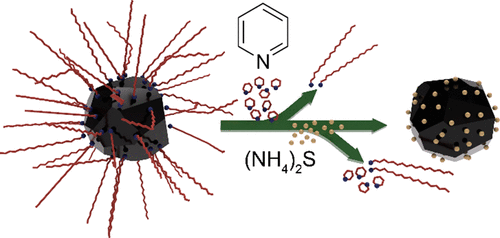当前位置:
X-MOL 学术
›
Chem. Mater.
›
论文详情
Our official English website, www.x-mol.net, welcomes your
feedback! (Note: you will need to create a separate account there.)
Hybrid Ligand Exchange of Cu(In,Ga)S2 Nanoparticles for Carbon Impurity Removal in Solution-Processed Photovoltaics
Chemistry of Materials ( IF 7.2 ) Pub Date : 2020-05-05 , DOI: 10.1021/acs.chemmater.0c00966 Ryan G. Ellis 1 , Jonathan W. Turnley 1 , David J. Rokke 1 , Jacob P. Fields 1 , Essam H. Alruqobah 1 , Swapnil D. Deshmukh 1 , Kim Kisslinger 2 , Rakesh Agrawal 1
Chemistry of Materials ( IF 7.2 ) Pub Date : 2020-05-05 , DOI: 10.1021/acs.chemmater.0c00966 Ryan G. Ellis 1 , Jonathan W. Turnley 1 , David J. Rokke 1 , Jacob P. Fields 1 , Essam H. Alruqobah 1 , Swapnil D. Deshmukh 1 , Kim Kisslinger 2 , Rakesh Agrawal 1
Affiliation

|
The solution processing of Cu(In,Ga)(S,Se)2 photovoltaics from colloidal nanoparticles has long suffered from deleterious carbonaceous residues originating from long chain native ligands. This impurity carbon has been observed to hinder grain formation during selenization and leave a discrete residue layer between the absorber layer and the back contact. In this work, organic and inorganic ligand exchanges were investigated to remove tightly bound native oleylamine ligands from Cu(In,Ga)S2 nanoparticles, thereby removing the source of carbon contamination. However, incomplete ligand removal, poor colloidal stability, and/or selective metal etching were observed for these methods. As such, an exhaustive hybrid organic/inorganic ligand exchange was developed to bypass the limitations of individual methods. A combination of microwave-assisted solvothermal pyridine ligand stripping followed by inorganic capping with diammonium sulfide was developed and yielded greater than 98% removal of native ligands via a rapid process. Despite the aggressive ligand removal, the nanoparticle stoichiometry remained largely unaffected when making use of the hybrid ligand exchange. Furthermore, highly stable colloidal ink formulations using nontoxic dimethyl sulfoxide were developed, supporting stable nanoparticle mass concentrations exceeding 200 mg/mL. Scalable blade coating of the ligand-exchanged nanoparticle inks yielded remarkably smooth and microcrack free films with an RMS roughness less than 7 nm. Selenization of ligand-exchanged nanoparticle films afforded substantially improved grain growth as compared to conventional nonligand-exchanged methods, yielding an absolute improvement in device efficiency of 2.8%. Hybrid ligand exchange nanoparticle-based devices reached total area power conversion efficiencies of 12.0%, demonstrating the feasibility and promise of ligand-exchanged colloidal nanoparticles for the solution processing of Cu(In,Ga)(S,Se)2 photovoltaics.
中文翻译:

Cu(In,Ga)S 2纳米粒子的混合配体交换,用于溶液处理光伏中的碳杂质去除。
胶态纳米粒子对Cu(In,Ga)(S,Se)2光伏电池的溶液加工长期以来一直遭受源自长链天然配体的有害碳质残基的困扰。已观察到该杂质碳会阻碍硒化过程中的晶粒形成,并在吸收层和背面触点之间留下离散的残留层。在这项工作中,有机和无机配体交换进行了研究,以从Cu(In,Ga)S 2中去除紧密结合的天然油胺配体纳米颗粒,从而消除了碳污染源。但是,对于这些方法,观察到配体去除不完全,胶体稳定性差和/或选择性金属蚀刻。因此,开发了详尽的杂化有机/无机配体交换以绕开各个方法的局限性。开发了微波辅助溶剂热吡啶配体汽提,然后用硫化二铵进行无机封端的组合,并通过快速工艺去除了超过98%的天然配体。尽管积极地去除了配体,但当使用杂合配体交换时,纳米粒子的化学计量仍基本不受影响。此外,还开发了使用无毒二甲亚砜的高度稳定的胶体油墨配方,支持超过200 mg / mL的稳定的纳米颗粒质量浓度。配体交换的纳米粒子墨水的可扩展叶片涂层可产生非常光滑且无微裂纹的薄膜,RMS粗糙度小于7 nm。与常规的非配体交换方法相比,配体交换的纳米颗粒薄膜的硒化可以显着改善晶粒的生长,从而使器件效率绝对提高了2.8%。基于混合配体交换纳米颗粒的器件达到了12.0%的总面积功率转换效率,证明了配体交换胶体纳米颗粒用于Cu(In,Ga)(S,Se)溶液加工的可行性和前景 与常规的非配体交换方法相比,配体交换的纳米颗粒薄膜的硒化可以显着改善晶粒的生长,从而使器件效率绝对提高了2.8%。基于混合配体交换纳米颗粒的器件达到了12.0%的总面积功率转换效率,证明了配体交换胶体纳米颗粒用于Cu(In,Ga)(S,Se)溶液加工的可行性和前景 与常规的非配体交换方法相比,配体交换的纳米颗粒薄膜的硒化可以显着改善晶粒的生长,从而使器件效率绝对提高了2.8%。基于混合配体交换纳米颗粒的器件达到了12.0%的总面积功率转换效率,证明了配体交换胶体纳米颗粒用于Cu(In,Ga)(S,Se)溶液加工的可行性和前景2个光伏。
更新日期:2020-06-23
中文翻译:

Cu(In,Ga)S 2纳米粒子的混合配体交换,用于溶液处理光伏中的碳杂质去除。
胶态纳米粒子对Cu(In,Ga)(S,Se)2光伏电池的溶液加工长期以来一直遭受源自长链天然配体的有害碳质残基的困扰。已观察到该杂质碳会阻碍硒化过程中的晶粒形成,并在吸收层和背面触点之间留下离散的残留层。在这项工作中,有机和无机配体交换进行了研究,以从Cu(In,Ga)S 2中去除紧密结合的天然油胺配体纳米颗粒,从而消除了碳污染源。但是,对于这些方法,观察到配体去除不完全,胶体稳定性差和/或选择性金属蚀刻。因此,开发了详尽的杂化有机/无机配体交换以绕开各个方法的局限性。开发了微波辅助溶剂热吡啶配体汽提,然后用硫化二铵进行无机封端的组合,并通过快速工艺去除了超过98%的天然配体。尽管积极地去除了配体,但当使用杂合配体交换时,纳米粒子的化学计量仍基本不受影响。此外,还开发了使用无毒二甲亚砜的高度稳定的胶体油墨配方,支持超过200 mg / mL的稳定的纳米颗粒质量浓度。配体交换的纳米粒子墨水的可扩展叶片涂层可产生非常光滑且无微裂纹的薄膜,RMS粗糙度小于7 nm。与常规的非配体交换方法相比,配体交换的纳米颗粒薄膜的硒化可以显着改善晶粒的生长,从而使器件效率绝对提高了2.8%。基于混合配体交换纳米颗粒的器件达到了12.0%的总面积功率转换效率,证明了配体交换胶体纳米颗粒用于Cu(In,Ga)(S,Se)溶液加工的可行性和前景 与常规的非配体交换方法相比,配体交换的纳米颗粒薄膜的硒化可以显着改善晶粒的生长,从而使器件效率绝对提高了2.8%。基于混合配体交换纳米颗粒的器件达到了12.0%的总面积功率转换效率,证明了配体交换胶体纳米颗粒用于Cu(In,Ga)(S,Se)溶液加工的可行性和前景 与常规的非配体交换方法相比,配体交换的纳米颗粒薄膜的硒化可以显着改善晶粒的生长,从而使器件效率绝对提高了2.8%。基于混合配体交换纳米颗粒的器件达到了12.0%的总面积功率转换效率,证明了配体交换胶体纳米颗粒用于Cu(In,Ga)(S,Se)溶液加工的可行性和前景2个光伏。











































 京公网安备 11010802027423号
京公网安备 11010802027423号